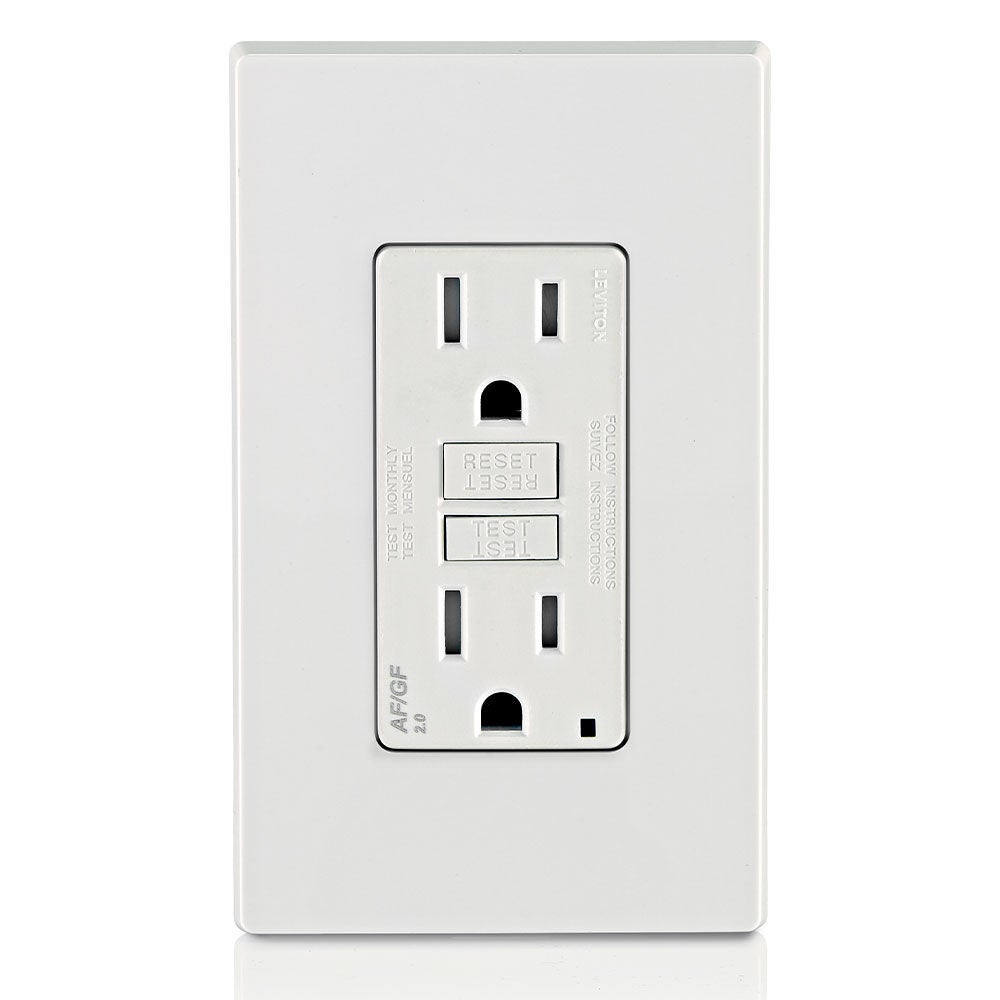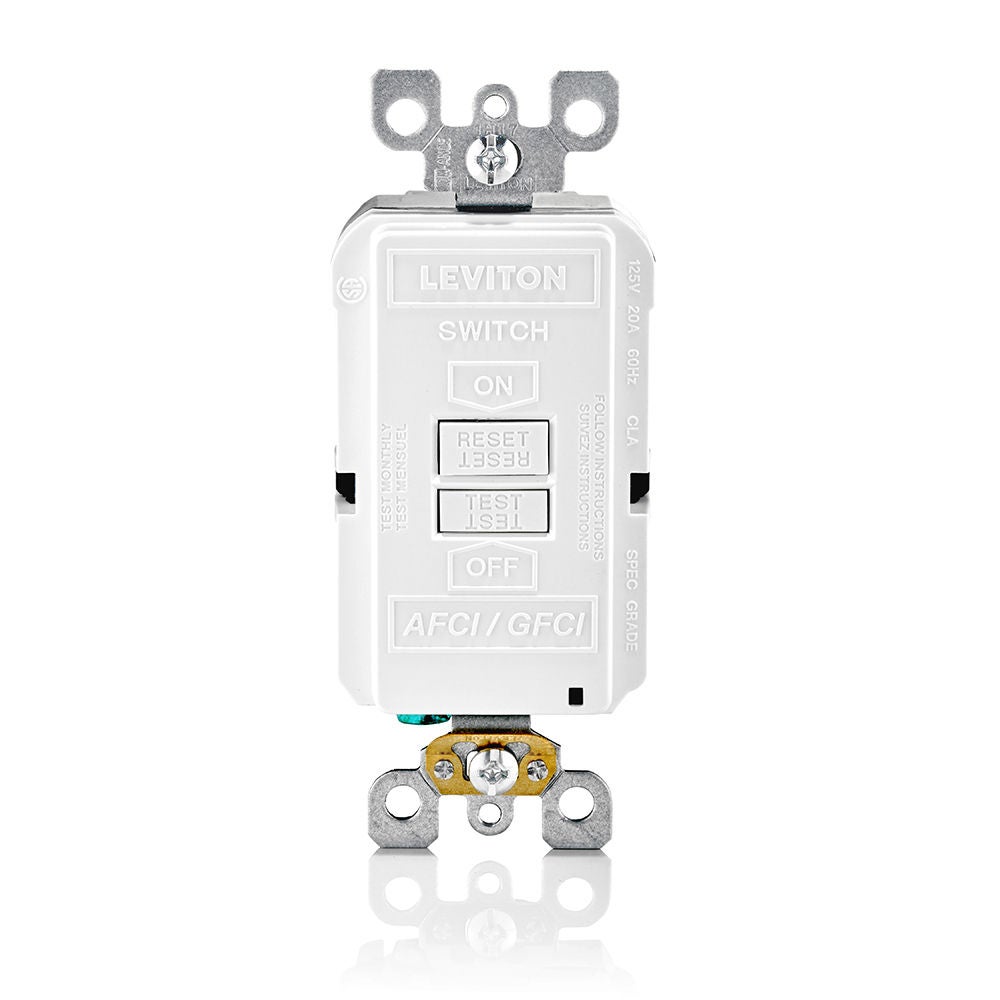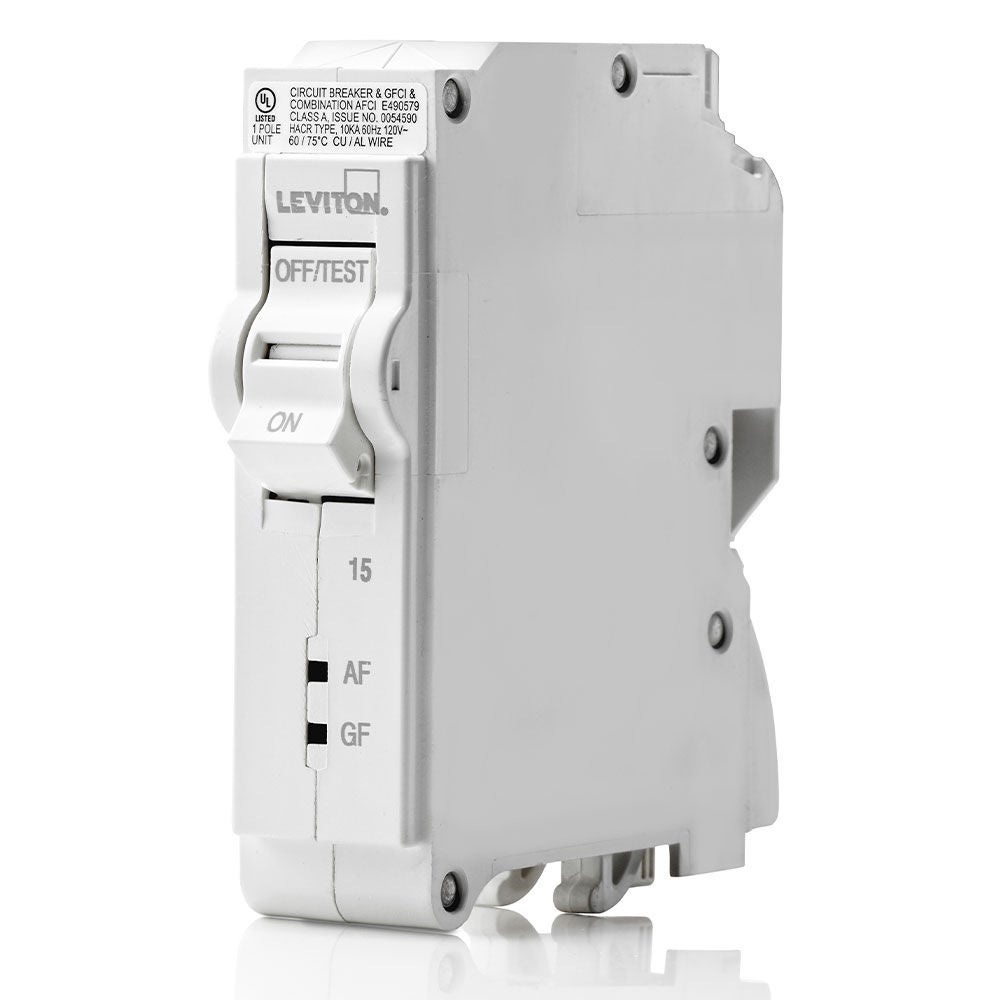No. The latest National Electrical Code requires both AFCI and GFCI protection only in kitchens and laundry rooms. And within those rooms, the Dual Function AFCI/GFCI Receptacle provides what is called “feed-through” protection, which means it provides protection for all wiring and extensions attached to the load side. If the Dual Function AFCI/GFCI replaces the first receptacle in the branch circuit, it will provide protection to the remaining outlets on that circuit.
Protection from electrical fires that could result from arc-faults and from electrical shock due to ground-faults is an important part of every home’s electrical system. Dual Function AFCI/GFCI receptacles and circuit breakers help to create a safer living environment by offering protection from both hazards in one smart device.
Advanced Technology
Dual Function AFCI/GFCI receptacles and circuit breakers help protect your home and family from both arc-faults (AFCI) and from ground-faults (GFCI) by working to detect these hazards. If detected, the devices quickly cut off power to help avoid a potential fire or shock occurrence.
- The status indicator light on the receptacle/circuit breaker provides a clear indication of the type of fault detected so users can properly address the issue
- The convenience of test and reset buttons on the face of the receptacle eliminates a trip to the service panel
- Our Dual Function AFCI/GFCI Circuit Breaker features the same patented reset lockout technology present in our receptacles and will not reset if protection is lost
Dual Function AFCI/GFCI receptacles and circuit breakers offer a National Electrical Code® (NEC®) compliant option for AFCI/GFCI protection in residential kitchens and laundry areas for new construction, modifications/extensions and replacements. Our receptacles are ideal as a replacement for ungrounded receptacles, satisfying NEC requirements for both AFCI and GFCI protection.
Learn more about the different types of protection
Infographics
Dual Function AFCI/GFCI Frequently Asked Questions
The function of an AFCI is to provide protection against potentially dangerous arc- faults helping to reduce the likelihood of the home's electrical system being an ignition source of a fire, potentially injuring people and damaging homes. The function of a GFCI is to directly protect people from the potentially fatal hazards of electric shock that could occur if parts of an electrical appliance or tool they are using become energized due to a ground fault. The Dual Function AFCI/GFCI Receptacle contains both technologies and offers both fire and shock protection in one smart device.
In 2014, the National Electrical Code® (NEC®) introduced AFCI requirements for kitchens and laundry rooms. The code had previously required that these locations needed only GFCI protection, but for added safety they are now required to have both AFCI and GFCI protection.
Additionally, there has long been a requirement for adding GFCI protection when replacing non-grounding type receptacles. Newer requirements include adding AFCI protection when replacing receptacles in various locations such as living rooms and bedrooms. The Dual Function AFCI/GFCI Receptacle provides an ideal solution for replacing receptacles in these circumstances.
Unless you are familiar with your home’s wiring, contact an electrician. If you are comfortable with replacing receptacles, to begin, TURN THE BREAKER OFF AND US A HAND HELD VOLTAGE TESTER TO CONFIRM POWER IS OFF at the outlet that you believe is the most likely to be first in the circuit. Remove the outlet and cap the wires. Turn the breaker back on and test the other outlets. If you chose correctly, all the others will be dead. If you chose incorrectly, TURN THE BREAKER OFF and put the original outlet back in and try another. Repeat the process until the first receptacle in the circuit is found.
Yes, all outlets require a neutral wire to work.
While Dual Function AFCI/GFCI Receptacles can work with a shared neutral on the line side, please refer to specific code requirements regarding acceptable methods for feeding an AFCI/GFCI receptacle. If you are unfamiliar with the function of a neutral wire, contact an electrician.
Yes, all Leviton Dual Function AFCI/GFCI Receptacles meet UL Standard 1699A (Arc-Fault Circuit-Interrupters, Outlet Branch Circuit Type) for AFCI, UL Standard 943 for Ground-Fault Circuit-Interrupters, and UL Standard 498 for outlets.
All Dual Function AFCI/GFCI Receptacles are rated as 20A feed-through. This means they can protect all outlets downstream on both 15A and 20A branch circuits.
The Dual Function AFCI/GFCI Receptacles are available through electrical distributors, retail and online merchants. Visit www.leviton.com/dfci and click “where to buy” for more information.
Yes, they both can be used on the same circuit; however, the Dual Function AFCI/GFCI Receptacle offers the option of providing both AFCI and GFCI protection in a single device.
An AFCI breaker is located in the service panel. Also, when tripped, an AFCI breaker requires the user to reset the breaker at the service panel. An AFCI/GFCI receptacle replaces a standard outlet and when tripped, requires the user to reset by pressing a button located on the outlet, often a more convenient option.
The NEC® identifies areas of the home that require AFCI protection and others that require GFCI protection as well as some that require both AFCI and GFCI protection. Dual Function AFCI/GFCI receptacles offer an NEC compliant option for AFCI/GFCI protection in kitchens and laundry areas for new construction, modifications/ extensions and replacement receptacles. For more information on code requirements visit www.leviton.com/protection
No, a combination type AFCI refers to a circuit breaker AFCI that offers both parallel and series arc protection. The term “combination” refers to parallel and series arc protection and does NOT refer to combined AFCI and GFCI protection; the term “dual” however does refer to AFCI and GFCI protection. Therefore, the Dual Function AFCI/GFCI Receptacle provides protection against arc-faults as well as ground faults in a single device.
In line with this, dual function AFCI/GFCI breakers offer both “combination” type (parallel and series) AFCI protection and GFCI protection.
AFCI receptacles also offer both series and parallel protection and are referred to as Outlet Branch Circuit (OBC) AFCI receptacles.
The AFCI/GFCI Receptacle can be a great alternative depending on the circumstance. The AFCI/GFCI Receptacle works with any type of wiring and is not dependent on the type of breaker in the panel. It is also easily accessible and has a level of familiarity with users with the TEST and RESET buttons that are also present on a GFCI receptacle.
The UL Standard for AFCIs defines an arc-fault as an unintentional arcing condition (sparking) in a circuit (wiring). Arcing creates high intensity heat (may exceed 10,000 degrees Fahrenheit) resulting in burning particles that may over time ignite surrounding material such as wood framing or insulation.
There are a wide range of conditions that may cause arcing, which is like an electrical spark:
Wire Degradation
- Natural degradation through age
- Humidity or heat
- Extended mechanical stress
- Extended voltage stress
Physical Damage
- Animals chewing through insulation
- Nails, tacks from construction or picture hanging driven into a
- wall puncturing or damaging a wire(s)
- Extension or power supply cord damage from sharp bends or
- furniture pressing on or against cords
- General cord damage
- Poor wiring or connection at devices/j-boxes
Yes. Leviton Dual Function AFCI/GFCI Receptacles are tamper-resistant to meet the latest National Electrical Code® child safety requirements. The shutter mechanism inside the outlet blocks access to the contacts unless a two-pronged plug is inserted.
Dual Function AFCI/GFCI Products
Resources
Do you have questions?
Do you have questions about our Dual Function AFCI/GFCIs?











